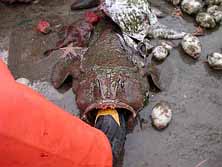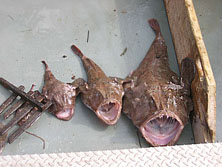Monkfish (Goosefish) (Lophius americanus)
- Monkfish population levels are higher than the newly-established biomass targets, and no overfishing is occurring.
- A rebuilding plan for Monkfish was established in 1999 and has included strict management measures to improve the health of monkfish stocks.
- Monkfish is low in sodium and is a good source of niacin, vitamins B6 and B12, and potassium and a very good source of protein, phosphorus, and selenium. For more on nutrition, see Nutrition Facts. (USDA)
- Almost all (97%) of monkfish sold in the U.S. are commercially harvested in U.S. waters.
|
 |
 |
 |
 |
| Nutrition Facts |
| Servings 1 |
| Serving Weight
100 g |
 |
| Amount Per Serving |
 |
| Calories 76 |
 |
| Total Fat |
1.52 g |
 |
| Total Saturated Fatty Acids |
0.34 g |
 |
| Carbohydrate |
0 g |
| Sugars |
0 g |
| Total Dietary
Fiber |
0 g |
 |
| Cholesterol |
25 mg |
 |
| Selenium |
36.5 mcg |
 |
| Sodium |
18 mg |
 |
| Protein |
14.48 g |
 |
|
 |
 Measuring a monkfish during a 2000 survey conducted by NMFS and commercial fishermen aboard the FV Warrior.
Measuring a monkfish during a 2000 survey conducted by NMFS and commercial fishermen aboard the FV Warrior.
|
 |
Did you know?
Monkfish are known as "all-mouth" - the fish is mostly head and the head is mostly mouth.
Adults spend most of their time resting on the bottom, often in a depression or partially covered in sediment. They prefer to be partially buried to support their ambushing method of predation.
Monkfish move by slowly swimming or by using the sturdy base of their pectoral fins to walk. They may also use wing-like extensions on their pectoral fins to "ride" currents.
Monkfish have been known to attack non-living objects such as lobster trap floats.
|
|
| |
 |
|
Monkfish are mostly mouth with a tail attached. They have been reported to eat prey nearly one-half their size and capture waterbirds at the surface.
|
 |
|
Often, only the meaty tails of monkfish make it to the table, so not many people who eat them have seen their huge mouths and heads adapted for hunting in deep water.
|
|
Sustainability Status
Biomass: Based on the results of the July 2007 stock assessment, Monkfish-North biomass is 29% above the biomass needed to support maximum sustainable yield (BMSY), and Monkfish-South biomass is 11 % above BMSY.
Overfishing: No
Overfished: No
Fishing and habitat: Monkfish are primarily caught by bottom trawls and gillnets. Dredges also account for a small percentage of landings. Monkfish habitat has been determined to be only minimally vulnerable to these fishing gears. An amendment was implemented in 2005 to address habitat issues through gear restrictions, area closures, and research programs.
Bycatch: Winter skates, thorny skates, and dogfish are the predominant species discarded in monkfish fisheries. There are also potentially significant interactions with red crab. A number of protected, threatened, and endangered species are found in the area of the fisheries regulated through the Monkfish FMP but not all are affected by the fishery. Measures have been implemented to reduce any impact.
Aquaculture: There is currently no commercial aquaculture of monkfish in the U.S.
|
Science and Management
In an effort to rebuild the fishery, the Monkfish Fishery Management Plan (FMP) was jointly adopted in 1999 by the New England and Mid-Atlantic Fishery Management Councils, with the New England Council having the administrative lead. Two stocks (North and South), based on differing fishery practices, are managed separately through the FMP. The Northern Fishery Management Area covers the Gulf of Maine and the northern part of Georges Bank; the Southern Fishery Management Area extends from the southern flank of Georges Bank through the Mid-Atlantic Bight to North Carolina. Fishery management measures include a total allowable catch, catch limits, incidental catch limits, closed seasons, minimum sizes (for fish and tails), minimum mesh size for trawls and gillnets, and effort controls. New regulations adopted in 2005 were designed to increase fishing opportunities while still meeting the conservation objectives of the FMP. They contain gear modifications and closures to protect Essential Fish Habitat. In May 2008, NOAA implemented new management measures to ensure the monkfish management program succeeds in keeping landings within the target total allowable catch levels. According to the most recent stock assessment, monkfish is not considered overfished, and overfishing is no longer occurring.
NOAA Northeast Fisheries Science Center runs the Cooperative Monkfish Research Program in collaboration with members of the monkfish industry. This program includes cooperative surveys to estimate monkfish population status, the Monkfish Research Set-Aside (RSA) Program, the Monkfish Egg Veil Sighting Network, and stock assessment workshops. The RSA program is carried out through the cooperation of both the New England and Mid-Atlantic Fishery Management Councils and NOAA's National Marine Fisheries Service (NMFS). This program sets aside 500 monkfish days-at-sea (DAS) from the directed monkfish fishery to be used for monkfish-related research endeavors. Revenues generated from monkfish harvested during these days are used to fund such research activities and compensate vessels. The recently established Monkfish Egg Veil Sighting Network helps scientists to better understand when and where monkfish spawn and where the egg veils travel after spawning.
|
Life History and Habitat
Life history, including information on the habitat, growth, feeding, and reproduction of a species, is important because it affects how a fishery is managed. Because monkfish have a general life history and adults and juveniles are so widely distributed, managers have been unable to identify unique or special habitat for them.
- Geographic range: In the Northwest Atlantic Ocean, from the Grand Banks and northern Gulf of St. Lawrence south to Cape Hatteras, North Carolina
- Habitat: Monkfish are bottom-dwelling - they are typically found on sand, mud, and shell habitats. They can tolerate a wide range of temperatures and depths from inshore up to at least 2,950 feet deep.
- Life span: Few males are seen older than age 7; females live longer than males, to at least 13 years and likely more
- Food: Monkfish are opportunistic feeders, feeding on whatever prey is available at the time. They mainly eat fish, including other monkfish, but also consume crustaceans, mollusks, seabirds, and diving ducks. Larvae feed on zooplankton (tiny floating animals); juveniles eat mostly small fish including sand lance, as well as shrimp and squid.
- Growth rate: Males and females have similar growth patterns up to age 6; thereafter, females are slightly larger than males.
- Maximum size: 35 inches for males, 55 inches for females
- Reaches reproductive maturity: At approximately 14 inches in length for males and 16 inches for females
- Reproduction: Female monkfish release large "egg veils" that can contain more than 1 million eggs. These egg veils float freely in the surface water according to the prevailing currents. They are thought to remain near the surface for 1 to 3 weeks (depending on temperature) until the egg veil disintegrates and the larvae hatch. The Northeast Fisheries Science Center runs the Monkfish Egg Veil Sighting Network to help scientists to better understand when and where monkfish spawn and where the egg veils travel after spawning. Scientists use the information on egg veil sightings along with satellite data and ocean circulation patterns to predict where eggs will hatch.
- Spawning season: February through October, progressing from south to north
- Spawning grounds: Unknown, though thought to be on inshore shoals and offshore over deep water
- Migrations: Seasonal; related to spawning and food availability
- Predators: Large monkfish have few predators. Small monkfish are eaten by various predacious fish including swordfish, sharks (dusky, sandbar, spiny dogfish, and smooth dogfish), and thorny skate. Monkfish have been observed in the stomachs of other monkfish, though cannibalism rates are probably quite low with the possible exception of large breeding females.
- Commercial or recreational interest: Commercial
- Distinguishing characteristics: Monkfish are described as mostly mouth with a tail attached because they have very broad heads and large mouths. Monkfish are capable of eating prey as long or longer than themselves.
|
Role in the Ecosystem
The monkfish is an ambush predator that uses its highly modified first dorsal fin as an angling apparatus to lure small fishes towards its mouth. Monkfish eat a wide array of prey items but mainly fish and cephalopods. Monkfish have been reported to ingest a variety of seabirds.
|
Additional Information
Market name: Monkfish
Vernacular names: Goosefish, Monktails, Angler, Fishing frog, Allmouth, Molligut, Abbot, Sea-devil, Lotte
*Monkfish is also the common and market name for other members of the genus Lophius (7 species), which are found in the Northeastern, Southeastern, and Southwestern Atlantic, and in the western North Pacific. Vernacular names for these species include Monk, Anglerfish, Goosefish, Allmouth, and Frogfish.
|
Biomass
 Biomass refers to the amount of monkfish in the ocean. Scientists cannot collect and weigh every single fish to determine biomass, so they use models to estimate it instead. These biomass estimates can help determine if a stock is being fished too heavily or if it may be able to tolerate more fishing pressure. Managers can then make appropriate changes in the regulations of the fishery. Biomass refers to the amount of monkfish in the ocean. Scientists cannot collect and weigh every single fish to determine biomass, so they use models to estimate it instead. These biomass estimates can help determine if a stock is being fished too heavily or if it may be able to tolerate more fishing pressure. Managers can then make appropriate changes in the regulations of the fishery.
Total biomass in the northern region declined steadily from the early 1980s through the early 1990s, remained at a relatively low level during the 1990s, and then increased after 1999, reflecting strong recruitment and management efforts from 2000 onwards. Biomass in the north was estimated to be 118,700 metric tons in 2006. In the south, total biomass increased until the late 1980s and then declined during the 1990s. Since 2000, biomass has increased in the south and was estimated to be 135,500 metric tons in 2006.
Prior to the 2007 stock assessment, a 3-year average of catch-per tow estimates from the NMFS fall trawl survey was used as a biomass estimate. The biomass thresholds contained in the FMP, which are used to determine whether a stock is overfished or not, were based on this 3-year average. In 1999, both the northern and southern stocks were determined to be overfished. In 2001, the northern stock was removed from the overfished list, and in 2003, the southern stock followed. However, 2005 fall trawl survey indices indicated that both stocks had again fallen below their overfished thresholds. New reference points were developed as part of the 2007 assessment. Based on these new reference points, monkfish in both management regions are not overfished and overfishing is not occurring. However, this assessment is considered to have a high level of uncertainty due to uncertainties in the biological and historical data, and the use of a new assessment model.
Landings
 Landings refer to the amount of catch that is brought to land. Until the 1970s, monkfish were considered bycatch and "trash fish" in trawls and scallop dredges. Growing international demand for monkfish tails and livers fueled the growth of U.S. landings in the 1980s and 1990s. By the mid-1990s, monkfish was the highest valued finfish in the northeastern U.S. By 2002, there were 718 U.S. commercial vessels with limited access permits for monkfish. Monkfish landings have declined since 2003 due to management restrictions. Landings refer to the amount of catch that is brought to land. Until the 1970s, monkfish were considered bycatch and "trash fish" in trawls and scallop dredges. Growing international demand for monkfish tails and livers fueled the growth of U.S. landings in the 1980s and 1990s. By the mid-1990s, monkfish was the highest valued finfish in the northeastern U.S. By 2002, there were 718 U.S. commercial vessels with limited access permits for monkfish. Monkfish landings have declined since 2003 due to management restrictions.
Reported total landings increased from an annual average of 2,500 metric tons in the 1970s to 8,700 metric tons in the 1980s, 23,000 metric tons in the 1990s, and 22,000 metric tons during 2000-2005. Total landings in 2006 declined to 14,500 metric tons, the lowest level since 1990, due to management regulations.
In the northern area, landings peaked in 2003 (15,000 metric tons), and have since declined to 6,700 metric tons in 2006. In the southern area, landings peaked in 1998 (19,300 metric tons), and declined to 7,800 metric tons in 2006.
Note: The landings presented are domestic commercial landings.
Biomass and Landings
 Are landings and biomass related? Landings are heavily dependent on biomass, management measures in the fishery, and fishing effort. Are landings and biomass related? Landings are heavily dependent on biomass, management measures in the fishery, and fishing effort.
Data sources:
Biomass and landings from Monkfish Assessment Summary for 2007
|
Important Dates
Mid-1980s – Directed trawl and gillnet fishery experiences rapid growth
1989 – European and Mediterranean monkfish species overfished spurring greater demand for U.S. monkfish
Early 1990s – Fishing industry expresses concerns over dramatically increased fishing mortality rates, gear conflicts, growing directed trawl fishery, and a decline in size of landed monkfish
1997 – Landings peaked at 62 million pounds (28,123 metric tons) and revenues of $35 million
1997 – Atlantic Large Whale Take Reduction Plan developed to reduce the likelihood of fishing gear entanglements of right, humpback, fin, and minke whales in the North Atlantic
1998 – Harbor Porpoise Take Reduction Plan requires gear modifications and area closures
1999 – Monkfish FMP implemented
1999 – Amendment 1 approved to ensure compliance with Essential Fish Habitat (EFH) requirements of the Magnuson-Stevens Act
2003 – Final rule implements series of seasonal closures to the use of large mesh gillnets in the EEZ off the coast of Virginia and North Carolina to reduce the impact of the monkfish fishery on endangered and threatened species of sea turtles
2005 – Amendment 2 addresses EFH, bycatch concerns, and issues raised by public scoping process
2007 – Interim management measures adopted in May to address overfishing while NMFS conducted a stock assessment. Framework 4 implemented in October to establish 3-year target total allowable catches (TACs), a target TAC backstop provision, and adjustments to days-at-sea and trip limits.
2008 – NOAA implements new management measures to ensure the monkfish management program succeeds in keeping landings within the target total allowable catch levels; measures include reduction in carryover days at sea, reduction in bycatch or incidental catch limits, and revision in the biological reference points used to determine if the stock is overfished
|
Notes and Links
General Information:
NOAA Northeast Fisheries Science Center Status of Fishery Resources off the Northeastern United States Goosefish Species Information
NOAA Technical Memorandum NMFS-NE-127 Essential Fish Habitat Source Document: Goosefish, Lophius americanus, Life History and Habitat Characteristics (1999)
NOAA's National Marine Fisheries Service (NMFS) Sustainability Species Identification for Monkfish
Fishery Management:
New England Fishery Management Council Monkfish Fishery Management information including FMP and amendments, SAFE reports, and updates
Stock Assessments:
Monkfish Assessment Summary for 2007
|
| |
|



